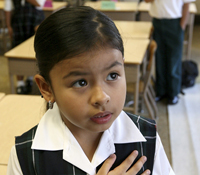
 On our homepage this week you’ll find Jeff Ziegler’s report on “The State of Catholic Schools in the US,” from our June 2011 issue.
On our homepage this week you’ll find Jeff Ziegler’s report on “The State of Catholic Schools in the US,” from our June 2011 issue.
In his article, Ziegler outlines in detail the reality already known to parents, teachers, and administrators all over the country: Catholic schools, at both the elementary and secondary level, are struggling:
With the average elementary school tuition now at $3,383 and the average secondary school tuition at $8,182, the same concerns about affordability that keep Latino parents from sending their children to Catholic schools are barriers to other parents as well. As expensive as tuition is for many Catholic families, it does not meet the actual per-pupil cost of Catholic schooling ($5,436 for elementary schools, $10,808 for secondary schools), according to the NCEA. …
Costs have risen largely because of the collapse of vocations to the religious life in the United States; the number of women religious (in previous decades the primary educators in Catholic schools) declined from 179,954 in 1965 to 57,544 in 2010. Today, only 2.6 percent of teachers in Catholic schools are nuns, 0.1 percent are brothers, and 0.3 percent are clergy, according to the NCEA; 84 percent are laywomen, and 13 percent are laymen. …
“What is the greatest challenge facing our Catholic schools today? Providing just compensation for our staff while protecting our families,” says Daryl Hagan, superintendent of schools for the Diocese of Evansville.
But the landscape of Catholic education in the US isn’t totally bleak; Ziegler highlights two dioceses in particular that have succeeded in improving the quality of education offered and in making that education more accessible to Catholic families:
Amid the collapse of Catholic primary and secondary education in the United States, episcopal support has helped lead to two extraordinary success stories: Memphis and Wichita.
Mary McDonald is superintendent of schools for the Diocese of Memphis, and she credits Bishop J. Terry Steib with the growth of schools in the diocese. With his support, she says, “we have increased the number of schools during the past 12 years from 16”—five of which were a year from closing—“to 29. We reopened eight long-closed schools in the inner city to address a population in poverty [and] opened a new high school for 1,000 and a few new elementary schools.” …
In 1998, Bishop Steib hired McDonald to reopen some of the closed schools. The Memphis Commercial-Appeal reported that McDonald’s success followed a brief 1999 meeting with Pope John Paul II, during which she asked him to pray for the Memphis schools. A month later, two Protestant businessmen gave $10 million, allowing for the reopening of several inner-city schools in one of the nation’s most violent urban areas. While the majority of the students in these inner-city schools are non-Catholic, all are required to attend Mass and pray the Rosary weekly, according to the Fordham Institute.
In Wichita, all Catholic primary and secondary schools have been tuition-free for Catholic students since 2002. Msgr. Thomas McGread, a legendary local pastor from 1968 to 1999, challenged his parishioners to donate 5 percent of their income to allow all of the parish’s children to attend the parish school for free. After parishioners obliged, he challenged them to donate 8 percent of their income so that the parish could pay for the Catholic high school tuition of any child in the parish. Again, the parishioners obliged. According to the Fordham Institute, Msgr. McGread’s vision spread throughout the diocese under the leadership of Bishop Eugene Gerber (1982-2001) and Voboril, who has served as superintendent since 1993.
Today, under the leadership of Bishop Michael Jackels, “Catholic schools in the Diocese of Wichita continue to grow because of our parishes’ commitment to fund the Catholic education of parish families without the need to charge tuition at the elementary or secondary levels,” Voboril told CWR. “Because of the tremendous generosity of our parishes to Catholic education and a growing commitment to serving all families regardless of income levels, ethnic background, language capability, or academic ability, our schools are unusually diverse. We have more than 2,600 ethnic minority students…and more than 700 students who come from homes where English is not the primary language.”
Ziegler’s complete report can be read here.
If you value the news and views Catholic World Report provides, please consider donating to support our efforts. Your contribution will help us continue to make CWR available to all readers worldwide for free, without a subscription. Thank you for your generosity!
Click here for more information on donating to CWR. Click here to sign up for our newsletter.


